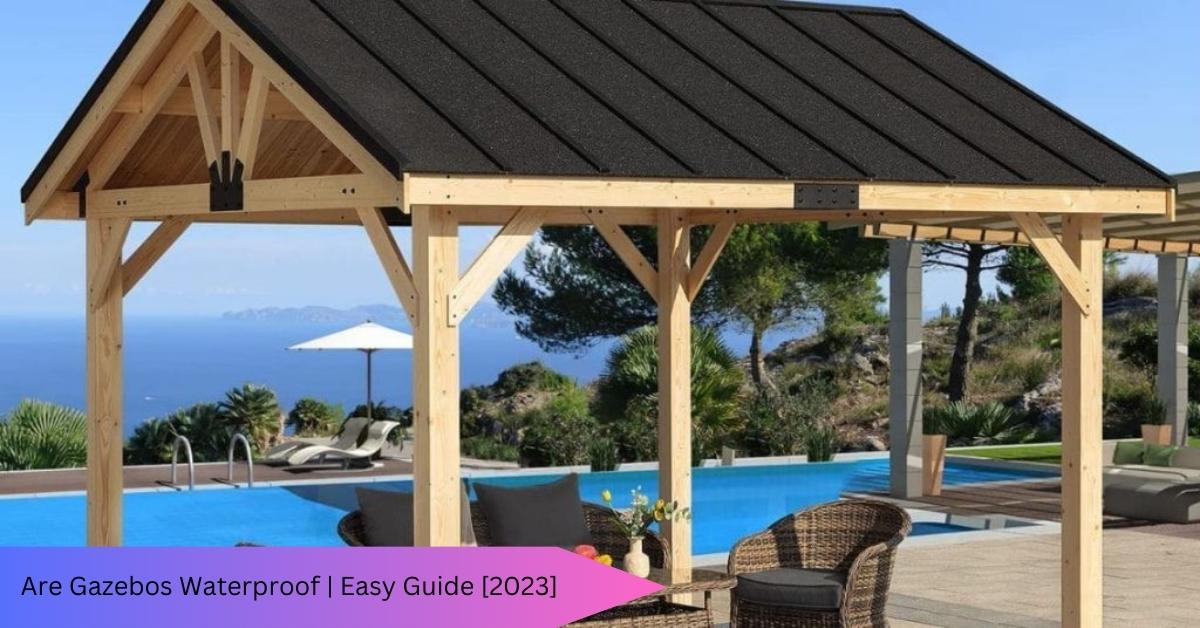I understand the importance of having a waterproof gazebo. It gives me peace of mind during rainy weather, ensuring that the interior remains dry and comfortable.
I have chosen a hardtop gazebo with a sloped roof design to facilitate water runoff, and I have taken additional steps to seal the seams and apply a waterproof coating to the surface.
These measures have proven to be effective in preventing water penetration and protecting my gazebo from issues like rot, mildew, or rust.
A waterproof gazebo allows me to enjoy its beauty and functionality throughout the year, knowing that my furniture and belongings are safe from water-related damage.
It’s an intelligent investment that ensures my gazebo stays in excellent condition and provides reliable shelter from the elements.
Are Gazebos Waterproof: Gazebos can be waterproofed with proper construction, materials, and methods. Waterproof gazebos ensure comfort and extend their lifespan, making them a worthwhile investment for outdoor enthusiasts.
Are Gazebos Waterproof?
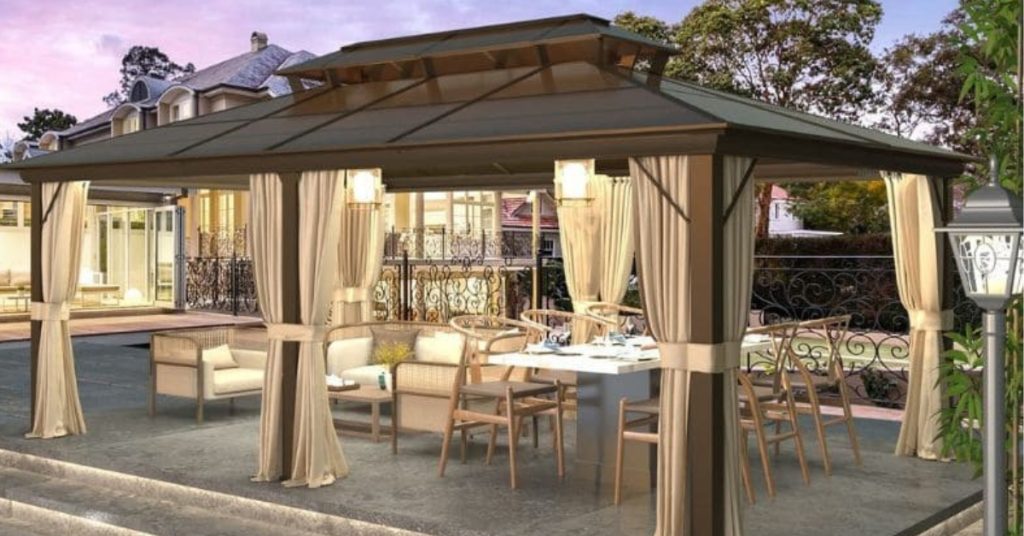
The answer to whether gazebos can be made waterproof depends on the material of the gazebo. If you have a wooden gazebo, it is possible to waterproof it.
However, if you have a plastic or another type of material gazebo, unfortunately, it cannot be made waterproof or rainproof.
Shielding Against Wind and Rain:
Many gazebo models come with detachable side panels but are not the same as tents. Tents are designed to keep the environment out, while gazebos are meant to help you enjoy them.
Canopies for gazebos are usually made of lightweight materials like polyester or PVC-coated fabrics, which make them easy to transport and set up.
However, these lightweight materials may not withstand heavy rainfall or tolerate puddles on the roof.
Pop-up gazebos are popular for garden parties but typically designed to handle light drizzles, not heavy downpours.
Wind is also a consideration, and double-roofed gazebos and hexagonal gazebos are designed to resist gusts from multiple directions.
It’s important to choose a gazebo with a sturdy frame made of steel or aluminum, depending on your needs, to ensure durability season after season.
Which Type Provides Reliable Rain Protection?
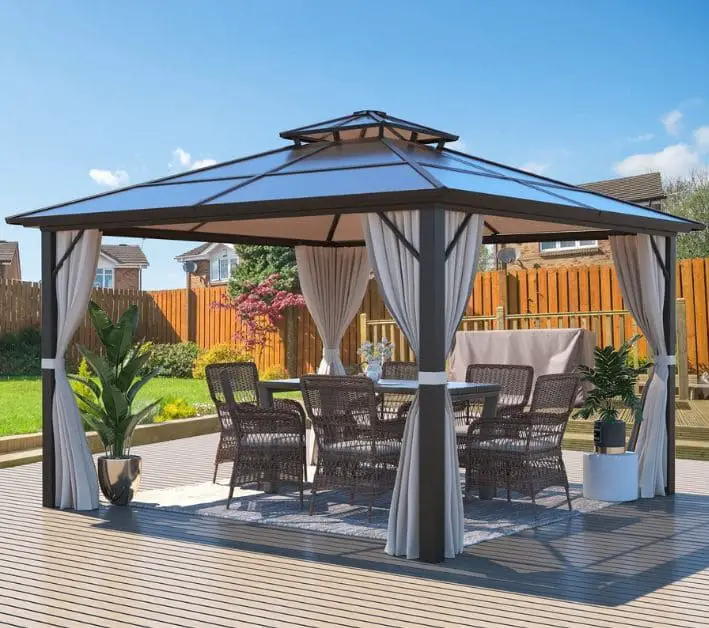
Gazebos with the Following Features for Enhanced Water Resistance
Durable Waterproof Coatings:
Most pop-up gazebo canopies are typically made from polyester, but what sets apart a leaky gazebo from a waterproof one is the additional treatments or coatings.
Before buying, it’s important to check if the canopy has been treated with a waterproofing chemical, such as
Fabsil, which can make it more resilient against wet weather.
This added protection helps enhance the water resistance of the gazebo canopy, ensuring that it can withstand rain and keep the interior dry.
Preventing Rust:
One aspect of gazebo maintenance that is often overlooked is protecting the frame from rust. Without proper waterproofing, steel and aluminium frames can rust over time, leading to wear and tear that can render the gazebo unusable.
To prevent rust, look for frames that are powder-coated. This involves applying a layer of polyester or epoxy powder to the frame, which is then heated to create a protective barrier that shields the metal from moisture and other environmental elements.
Powder-coated frames provide an extra layer of defense against rust and can help extend the lifespan of your gazebo, ensuring it remains in good condition for years to come.
Polyester Canopies with Lining:
Using polyester canopies with lining is a great way to enhance the waterproofing of gazebos. Cheaper gazebo canopies often use single sheets of polyester, which may not provide sufficient water resistance.
Polyester, when used in thin sheets without lining, can absorb water and lead to leaks.
However, polyester canopies that are properly treated and lined with another material, such as PVC, can offer superior water resistance and essentially be waterproof.
For example, our canopies are lined with PVC on the inside to prevent water from seeping through into the gazebo.
Waterproof Seams:
Sealing the seams of a gazebo canopy with silicone seam sealant can provide extra protection against leaks.
The stitches and corners of the canopy are vulnerable areas that may allow water to penetrate, but applying a sealant can help prevent this issue.
Is it possible to Waterproof my Gazebo on my own?
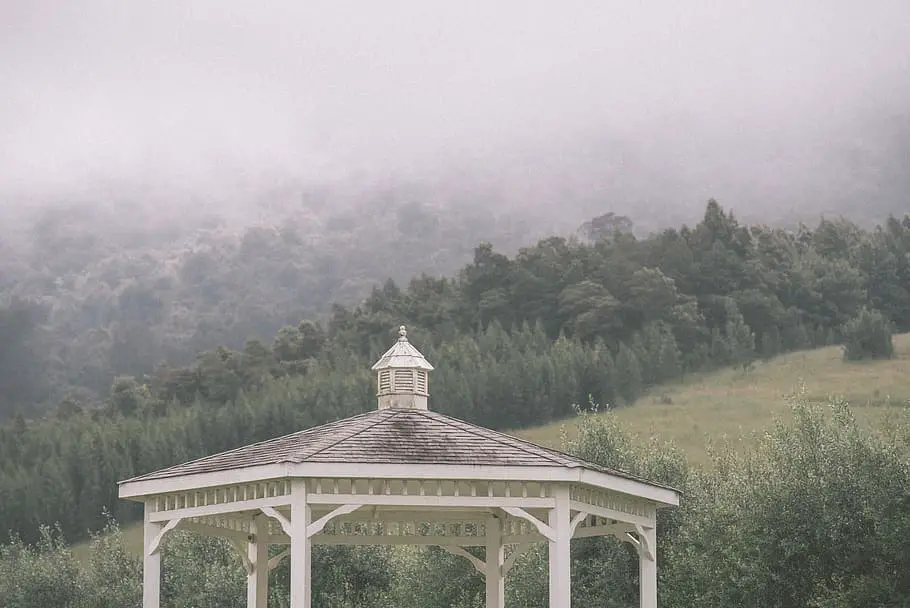
If your gazebo’s water resistance is diminishing over time, you can rejuvenate it by applying a product like Fabsil.
To do this, you’ll need to remove the canopy from the frame, clean it, and then spray on the coating according to the instructions provided by the manufacturer.
This can help restore the water-resistant properties of the canopy and keep it protected against rain and moisture.
How can I enhance the Waterproofing of my Gazebo?
There are a few options to consider. One option is to use a waterproofing kit that includes adhesive, primer, and paint to seal both the interior and exterior of the gazebo. However, these kits can be expensive.
Another option is to use a spray-on or roll-on product designed for outdoor use on vinyl or composite structures.
These products may come with or without primers and provide varying levels of protection. Considering your desired finish and budget can help guide your decision.
What are effective methods to waterproof my Gazebo?
To waterproof a wooden gazebo, you can follow these steps:
- Apply primer to the wood to prepare it for painting.
- Paint the gazebo with exterior latex or acrylic paint.
- Optionally, apply a water-based sealant on top of the paint for extra protection.
- Apply another coat of sealer after two weeks to prevent mildew, or sooner if there has been heavy rain recently.
This will help protect your gazebo from moisture and extend its lifespan.
What are some Indicators that a Gazebo may not have Adequate Waterproofing and Weatherproofing?
Some potential red flags that a gazebo may not be effectively waterproof or weatherproof could include:
- Having a single sheet of polyester without any lining or additional protective layers.
- Lack of water-resistant chemical treatment on the canopy.
- Absence of sealant or extra protection on seams and stitches.
- Frames that are not powder-coated for added rust resistance.
Is it possible to make a Wooden Gazebo Waterproof?
There are several methods that can be used to make a wooden gazebo waterproof. Here are some options:
Waterproofing Solutions for Wooden Gazebos:
A waterproofing membrane is a technique that involves applying a special material to all sides of a wooden gazebo before attaching any other components.
This material creates a tight seal that prevents water from entering through cracks or joints, keeping the gazebo waterproof.
A Paint:
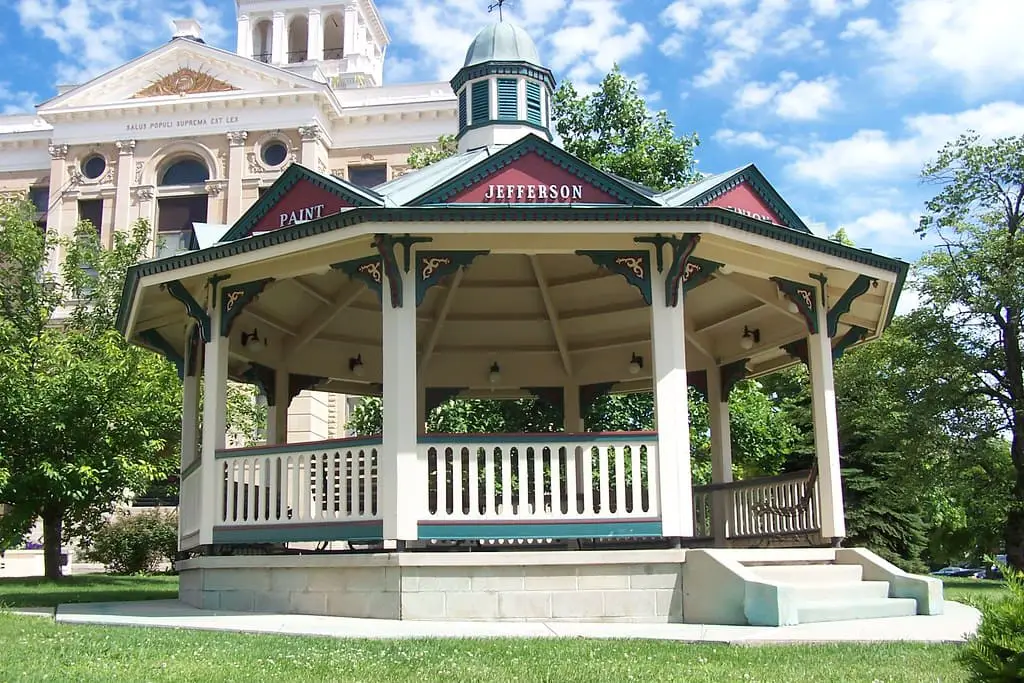
Painting is a simple and DIY-friendly way to waterproof a gazebo. Various types of outdoor paints are available, including those with UV protection and weather resistance.
However, it’s important to ensure that the paint you use is specifically designed for outdoor use and not just meant for indoor applications like the interior walls of buildings.
How can you make a wooden gazebo waterproof?
There are two main ways to waterproof a wooden gazebo: sealing the wood or painting it with waterproof paint.
Sealing the wood is a more permanent option but may lead to cracks over time. Painting with waterproof paint can prevent moisture penetration but may affect the appearance of the pavilion.
What methods are Recommended for effectively Waterproofing a Wooden Gazebo?
Here are some bullet points on methods to waterproof a wooden gazebo:
- Sealer for wood
- Primer for wood
- Topcoat for wood
- Stain for wood
- Waterproofing agent for wood (such as Thompson’s Water Seal)
- Waterproofing compound for wood (such as Thompson’s Water Shield)
- Waterproofing paint for wood (such as Thompson’s Water-Borne)
Is it possible to construct a gazebo during snowy conditions?
Although building a gazebo in snowy conditions is technically possible, it is not recommended. To prevent the snow from melting and causing issues, you would need to insulate the gazebo using a drop cloth or tarp as you construct the walls and roof.
Additionally, it is advisable to use materials like plywood for the flooring instead of carpet, as it is more durable and can better handle the weight of snow.
Building in snowy conditions may pose risks, and it’s important to ensure proper strength and weight distribution to avoid potential collapse when warmer weather arrives.
Is it possible to construct a gazebo during rainy weather?
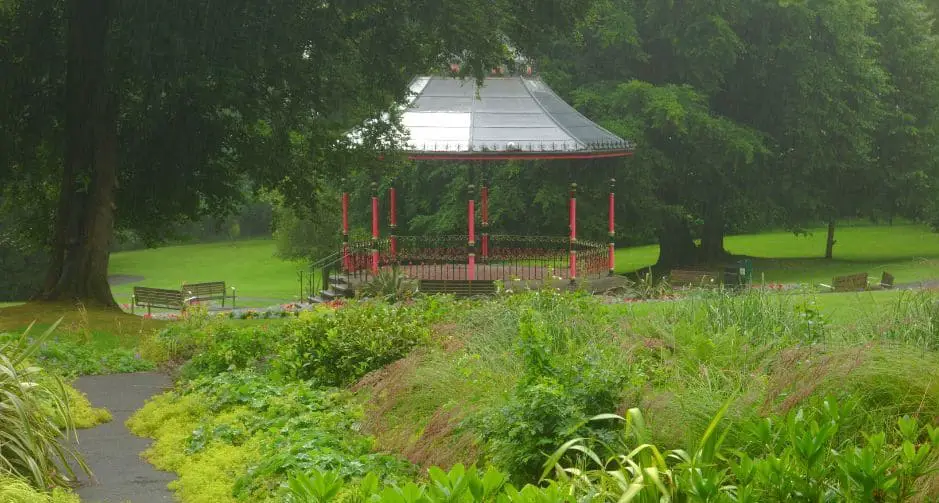
You can build a gazebo even in rainy weather, but it’s important to start on a dry day with no chance of precipitation.
If it starts raining while you’re in the middle of construction, cover your supplies or bring them indoors until the weather clears.
It’s also a good idea to have a shelter for your tools nearby to keep them dry.
Types of Gazebos
There are several different types of gazebos, including:
Open-Sided Gazebos:
These gazebos typically have an open design with a roof but no walls or only partial walls. They provide a sense of openness and are often used for enjoying views or as a focal point in a garden or outdoor space.
Open-sided gazebos can be made of various materials such as wood, metal, or vinyl, and they offer a versatile and airy space for relaxation or entertainment.
Closed-Sided Gazebos:
These gazebos have solid walls or screens on some or all sides, providing more privacy, protection from insects, and shelter from wind or rain.
They can have windows, doors, or other design elements for added functionality and aesthetics.
Closed-sided gazebos are ideal for creating a cozy and enclosed outdoor room for various purposes, such as dining, lounging, or as a garden retreat.
Canopy Gazebos:

Canopy gazebos feature a fabric or canvas canopy that provides shade and protection from the sun, making them a popular option for hot or sunny climates.
They are often lightweight, portable, and easy to set up, making them suitable for temporary or seasonal use.
Canopy gazebos come in various styles and sizes, and they are versatile for different outdoor events, and gatherings, or as a convenient shade solution in outdoor spaces.
Hardtop Gazebos:
Hardtop gazebos are characterized by a solid, durable roof made of metal, wood, or polycarbonate, offering more permanent and long-lasting protection from the elements.
They are typically more sturdy and durable than other types of gazebos, and they often have additional features like built-in ventilation, lighting, or screens.
Hardtop gazebos are popular for creating a permanent outdoor room or entertainment area that can be used year-round, regardless of the weather conditions.
Waterproofing Methods for Gazebos
There are several methods for waterproofing gazebos to protect them from moisture and ensure durability:
Fabric Waterproofing:
For canopy gazebos with fabric canopies or curtains, applying a fabric waterproofing spray or liquid can help repel water and keep the fabric dry.
These products can be easily applied to the fabric surface and should be reapplied periodically, especially after heavy rainfall or prolonged exposure to moisture.
Fabric waterproofing products can help prevent the fabric from becoming waterlogged and extend its lifespan.
Seam Sealing:
Gazebos with seams, such as those made of fabric or vinyl, may benefit from seam sealing. Seam sealing involves applying a specialized sealant or adhesive to the seams of the gazebo to prevent water from seeping through the seams.
This can be particularly useful in preventing leaks and maintaining the waterproofing integrity of the gazebo.
Coating and Sealing:
Applying a waterproofing coating or sealant to the surfaces of a wooden or metal gazebo can help create a barrier against water penetration.
This can involve using products such as waterproofing paint, varnish, or sealants designed for wood or metal surfaces.
These products can help protect the gazebo from moisture-related issues such as rot, rust, or decay.
Roof Design:
The design of the gazebo’s roof can also play a role in its waterproofing. A well-designed roof with a steep slope can help water drain off quickly and prevent pooling or water accumulation, reducing the risk of leaks or water damage.
Additionally, adding features such as overhangs, gutters, or downspouts can help divert water away from the gazebo and keep it dry.
Drainage System:
Installing a proper drainage system around the gazebo can help manage water runoff and prevent water from pooling around the base of the gazebo, which can lead to water seeping into the gazebo’s foundation or flooring.
This can involve installing gutters, downspouts, or French drains, depending on the specific needs of the gazebo and its surroundings.
Overall, a combination of fabric waterproofing, seam sealing, coating and sealing, appropriate roof design, and a proper drainage system can help effectively waterproof a gazebo and protect it from moisture-related issues, ensuring its longevity and durability.
It’s important to follow the manufacturer’s instructions and choose the appropriate waterproofing methods and products for the type of gazebo and its materials.
Benefits of Waterproof Gazebos
Waterproof gazebos are outdoor structures that are designed to provide shelter from the elements, particularly rain, and moisture.
These gazebos are made from materials that are resistant to water and are constructed in a way that prevents water from seeping through. Here are some benefits of waterproof gazebos:
Protection from Rain:
A waterproof gazebo ensures that you and your guests stay dry during rainy weather. It allows you to enjoy your outdoor space regardless of the weather, making your gazebo a functional and usable space all year round.
You can have outdoor gatherings, and parties, or simply relax in your gazebo without worrying about getting wet.
Extended Lifespan:
Waterproof gazebos are built to withstand the elements, including rain and moisture, which can cause damage to gazebos made of materials that are not water-resistant.
By investing in a waterproof gazebo, you can extend its lifespan and ensure that it remains in good condition for years to come, saving you money in the long run.
Comfort and Usability:
A waterproof gazebo provides a comfortable and usable outdoor space even during rainy weather. You can set up furniture, such as chairs, tables, and outdoor cushions, without worrying about them getting wet.
This allows you to fully utilize your gazebo for various activities, such as dining, lounging, or working, without being interrupted by rain.
Preservation of Furniture and Belongings:
Waterproof gazebos protect your furniture, belongings, and other outdoor items from getting damaged by rain and moisture.
This is especially important for outdoor furniture, cushions, and other accessories that may not be designed to withstand prolonged exposure to water.
With a waterproof gazebo, you can keep your furniture and belongings dry and in good condition for longer, reducing the need for replacement or repair.
Easy Maintenance:
Waterproof gazebos are typically made from materials that are easy to clean and maintain. The water-resistant features of these gazebos make it easier to clean off dirt, debris, and watermarks, keeping your gazebo looking clean and well-maintained with minimal effort.
Overall, a waterproof gazebo offers several benefits, including protection from rain, extended lifespan, comfort and usability, preservation of furniture and belongings, and easy maintenance.
Investing in a waterproof gazebo can enhance your outdoor space, allowing you to enjoy it regardless of the weather conditions, while also protecting your furniture and belongings from moisture damage.
Factors to Consider in Waterproof Gazebos
When choosing a waterproof gazebo, there are several factors to consider to ensure that you select the right one for your needs. These factors include:
- Material:
The material used in the construction of a waterproof gazebo is crucial for its waterproofing performance. Common materials used in waterproof gazebos include treated wood, aluminum, steel, or waterproof fabric.
Treated wood gazebos are often resistant to moisture and rot, but may require regular sealing or staining. Aluminum and steel gazebos are durable and resistant to rust but may be more expensive.
Waterproof fabric gazebos are lightweight and easy to clean but may require the reapplication of waterproof coatings over time.
Consider the pros and cons of different materials based on your preferences and needs.
- Quality:
The quality of the waterproof gazebo is important for its overall durability and effectiveness in keeping water out.
Look for gazebos from reputable manufacturers known for producing high-quality outdoor structures.
Check for features such as reinforced seams, weather-resistant zippers, and sturdy frames that can withstand wind and rain.
Reading customer reviews and ratings can also provide insights into the quality of the gazebo.
- Maintenance:
Consider the maintenance requirements of the waterproof gazebo before making your decision. Some gazebos may require regular maintenance, such as sealing, staining, or applying waterproof coatings, to ensure continued waterproofing performance.
Others may require minimal maintenance, such as occasional cleaning. Consider the level of maintenance you are willing to commit to and choose a waterproof gazebo that fits your preferences and lifestyle.
- Climate:
The climate in your area is an important factor to consider when choosing a waterproof gazebo. If you live in an area with heavy rainfall, snow, or high humidity, you’ll need a specifically designed gazebo to withstand such weather conditions.
Look for gazebos with strong frames, waterproof fabric or material, and proper ventilation to prevent condensation build-up.
Consider your area’s climate and choose a waterproof gazebo that is suitable for the weather conditions you typically experience.
- Budget:
Your budget is a practical consideration when choosing a waterproof gazebo. Waterproof gazebos come in a wide range of prices, so it’s important to determine your budget beforehand.
Remember that higher-priced gazebos may offer better quality, durability, and features but may not always be necessary depending on your specific needs and preferences.
Set a budget that aligns with your financial constraints, and look for a waterproof gazebo that balances quality and affordability.
By considering factors such as material, quality, maintenance requirements, climate, and budget, you can decide when choosing a waterproof gazebo that best fits your needs, preferences, and budget.
FAQs:
Q:1 Can gazebos provide protection from the rain?
Gazebos are designed to offer shelter from the weather, providing a shaded area on sunny days and a covered space during rain. They serve as a place to seek refuge from the sun or rain while enjoying outdoor activities.
Q:2 Are gazebos able to withstand heavy rain?
Some gazebos are made with heavier fabrics that can withstand heavier rainfall but may not be designed to handle puddles on the roof. Pop-up gazebos, commonly used for garden parties, are typically only suitable for drizzles and may not hold up well in heavy downpours.
It’s also important to consider wind as a factor, as strong winds can impact the stability and durability of a gazebo during rain.
Q:3 How can you waterproof a gazebo?
If your gazebo is made of canvas and you want to make it waterproof, you can buy a waterproofing spray. You’ll need to apply two coats of the spray – the first one coats the material, and the second one seals the finish. Check the weather forecast and choose a day when it’s dry to do this job, as the spray needs time to dry properly.
Q:4 What are some ways to cover a gazebo during rain?
You can cover your gazebo with a tarp to protect it from rain and rot. Use rubber tie-downs to secure the tarp by hooking them to the tarp’s corners and attaching the other end to a strong beam or horizontal support on your gazebo. This will help keep your gazebo dry and prevent damage from water.
Q:5 Is it safe to leave gazebos out in the winter?
In simple terms, yes, you can leave a pop-up gazebo outside. However, it’s not recommended to do so for extended periods, especially during colder or harsh weather, as it can cause damage to the pavilion. It’s best to take precautions and protect your gazebo from adverse weather conditions to ensure its longevity.
Q:6 Can gazebos be left up permanently?
You can keep gazebos with a hard roof, such as those made of vinyl, metal, composite wood, or pressure-treated wood, up all year-round. These gazebos are designed to withstand the elements and can be left standing without any issues, regardless of the season.
Q:7 What is the recommended waterproofing method for gazebos?
Gazebo canopies made of thin polyester may absorb water if they don’t have an extra PVC lining or waterproofing treatment. However, if the polyester is treated with polyurethane (PU), it can have excellent waterproofing properties, helping to keep the canopy dry even in wet conditions.
Conclusion:
In conclusion, as a knowledgeable AI, I would like to share that gazebos can vary in their waterproofing capabilities depending on the materials used and their construction.
Hardtop gazebos made of vinyl, metal, composite wood, or pressure-treated wood are generally designed to be waterproof and can be left up year-round without any issues.
On the other hand, gazebo canopies made of thin polyester may absorb water if they lack an extra PVC lining or waterproofing treatment.
However, canopies treated with polyurethane (PU) can offer good waterproofing qualities, helping to keep the canopy dry in wet conditions.
It’s important to remember that even with waterproofing measures in place, no gazebo is completely impervious to extreme weather conditions, especially heavy rain, snow, or high winds.
It’s always a good idea to take precautions and protect your gazebo from harsh weather by using additional waterproofing sprays, tarps, or other protective measures as needed.
We hope you will be well aware that “Are gazebos waterproof?”, after reading this comprehensive article. if you have any questions, feel free to comment below!

